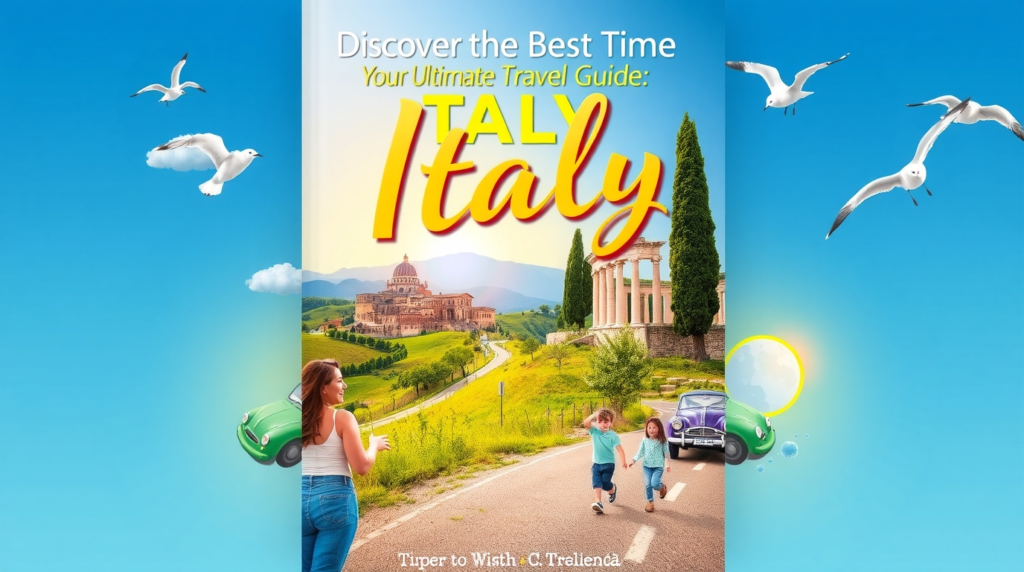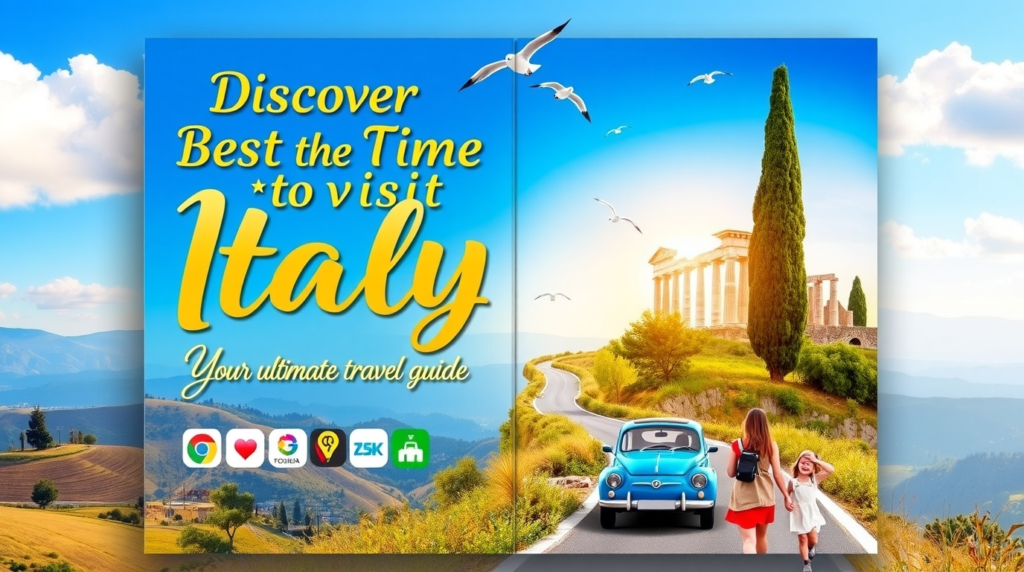The Best Time to Visit Italy depends on what you want to see and do. Italy is full of beautiful cities, stunning countryside, and amazing beaches. Each season has something special to offer. Spring and fall are often the most popular because the weather is pleasant, and there are fewer crowds. Summer is perfect if you love festivals, sun, and beaches, but it can be very busy in famous cities like Rome, Venice, and Florence. Winter is quieter, and it’s the ideal time to enjoy skiing in the Alps or exploring museums without waiting in long lines. Planning your trip at the right time can make your Italy experience more enjoyable, cost-effective, and stress-free. Understanding the weather, tourist seasons, and local events will help you pick the perfect time for your Italian adventure.
Italy is a country with diverse experiences in every region, which is why knowing the best time to visit Italy matters. If you love history and architecture, spring and autumn are ideal because the temperatures are comfortable for sightseeing in cities like Rome and Florence. Food lovers might prefer late summer and early autumn when fresh seasonal produce, wine festivals, and harvest celebrations are at their peak. For beach vacations, the Italian coast shines in July and August, but you should be ready for crowds and higher prices. Winter offers a different kind of charm, with snow-capped mountains in the north and cozy trattorias in the south. No matter what season you choose, Italy has something unique to offer. With the right planning, you can enjoy stunning landscapes, cultural events, delicious food, and unforgettable memories while avoiding the busiest tourist times.

Best Time to Visit Italy for Sightseeing and Culture
If your goal is to explore Italy’s cities, museums, and historical sites, spring (April to June) and autumn (September to October) are the best months. During these seasons, the weather is mild, the skies are clear, and walking around famous cities like Rome, Florence, and Venice is comfortable.
Summer can be very hot, especially in southern Italy, and the most popular cities are crowded with tourists. Winter is quieter but can be chilly and rainy in many areas. Spring and autumn also offer beautiful scenery, with blooming flowers or colorful fall leaves adding magic to your photos. Planning sightseeing during these months means shorter lines at attractions and a more relaxed experience.
Best Time to Visit Italy for Food and Wine Lovers
Italy is famous for its food and wine, and the timing of your trip can make a big difference in your culinary experience. Late summer and early autumn (August to October) are ideal for food lovers because it’s harvest season. You can enjoy fresh grapes, olives, truffles, and seasonal fruits. Many regions hold food and wine festivals where you can taste local specialties and meet producers.
Northern Italy is especially famous for truffle festivals in autumn, while Tuscany and Piedmont celebrate wine harvests with tastings and events. Visiting during this time also means you get to enjoy seasonal menus at restaurants, making your culinary journey more authentic. Winter is another great time for food lovers, as hearty Italian dishes like polenta, risotto, and winter vegetables are in season.
Best Time to Visit Italy for Beaches and Coastal Towns
If you are dreaming of sunny beaches, the best time to visit Italy is late May to September. Coastal areas like the Amalfi Coast, Cinque Terre, Sicily, and Sardinia are perfect for sunbathing, swimming, and exploring charming seaside towns during these months.
July and August are peak season for tourists, so expect higher prices and crowded beaches. Early summer (May and June) or early autumn (September) can be a better choice if you want warm weather without massive crowds. Coastal Italy is not just about beaches—visiting small fishing villages, enjoying fresh seafood, and taking scenic boat trips are all part of the experience.
Best Time to Visit Italy for Winter Adventures
Winter in Italy (December to February) is magical in a different way. The Alps and Dolomites are famous for skiing, snowboarding, and winter sports. Towns like Cortina d’Ampezzo and Madonna di Campiglio offer world-class slopes and cozy mountain lodges.
Winter is also the quietest season for visiting cities, meaning fewer crowds at museums and historic sites. Italian cities celebrate Christmas and New Year with beautiful lights, markets, and festive events. Southern Italy is milder during winter, making it a good choice for travelers who want to escape the cold. Visiting Italy in winter is perfect for those who love snow, quiet streets, and traditional Italian winter food.
How Weather Affects the Best Time to Visit Italy
Italy’s weather varies greatly between the north and south. Northern Italy can be cold and snowy in winter but pleasant in spring and summer. Southern Italy enjoys mild winters and hot summers. Rain is more common in spring and autumn, especially in coastal areas, but it rarely ruins a trip.
Checking regional weather patterns is essential when planning your trip. If you want warm sunny days, late spring and summer are the safest options. If you want cooler, comfortable temperatures for walking and sightseeing, spring and early autumn are ideal. Understanding the weather will help you pack properly and enjoy your trip without surprises.

Festivals and Events: The Best Time to Visit Italy for Celebrations
Italy is full of festivals, parades, and cultural events throughout the year. Timing your visit with a festival can make your trip unforgettable.
- Carnival in Venice (February/March): Masks, costumes, and parades.
- Palio di Siena (July/August): Famous horse race in Tuscany.
- Umbria Jazz Festival (July): Jazz music in historic towns.
- Grape and Wine Festivals (September/October): Taste the season’s best harvest.
Visiting Italy during a festival means you can experience local traditions, music, and food, creating memories beyond sightseeing.
Avoiding Crowds: Smart Tips for Visiting Italy at the Right Time
Italy is a popular destination, so avoiding crowds can improve your experience. Spring and autumn are the best seasons to enjoy sightseeing with fewer tourists. Summer is the busiest, especially in Rome, Venice, Florence, and the Amalfi Coast. Winter is quiet, but some attractions or coastal towns may have limited services.
Booking accommodations and attractions in advance, traveling during weekdays, and exploring less-famous towns are ways to enjoy Italy without the crowds. Smart planning allows you to see the best of Italy while keeping your trip relaxing and enjoyable.
Season-by-Season Guide: Best Time to Visit Italy
- Spring (March to June): Mild weather, blooming landscapes, ideal for sightseeing.
- Summer (June to August): Beach time, festivals, busy tourist season.
- Autumn (September to November): Harvest season, food festivals, pleasant weather.
- Winter (December to February): Skiing in the Alps, Christmas markets, quiet cities.
Each season offers unique experiences. Decide what you want to do, and pick the season that matches your interests.

Conclusion
The best time to visit Italy depends on your travel goals. Spring and autumn are ideal for sightseeing and comfortable weather. Summer is perfect for beaches and festivals, while winter offers skiing and quiet exploration. By understanding the weather, festivals, and tourist seasons, you can plan a trip that matches your interests and enjoy Italy to the fullest.
FAQ:
Q1: When is the cheapest time to visit Italy?
A1: Winter (December to February) is usually the cheapest time, except during Christmas and New Year.
Q2: What is the best month to visit Italy for sightseeing?
A2: May, June, September, and October are perfect for sightseeing with mild weather and fewer crowds.
Q3: When is the best time for beaches in Italy?
A3: Late May to September is ideal for warm sun and swimming.
Q4: Is Italy crowded in summer?
A4: Yes, summer (July and August) is peak tourist season, especially in Rome, Venice, Florence, and coastal areas.
Q5: Can I enjoy festivals in Italy during winter?
A5: Yes, winter has Christmas markets, Carnival in Venice, and some cultural events, though summer has more festivals overall.


